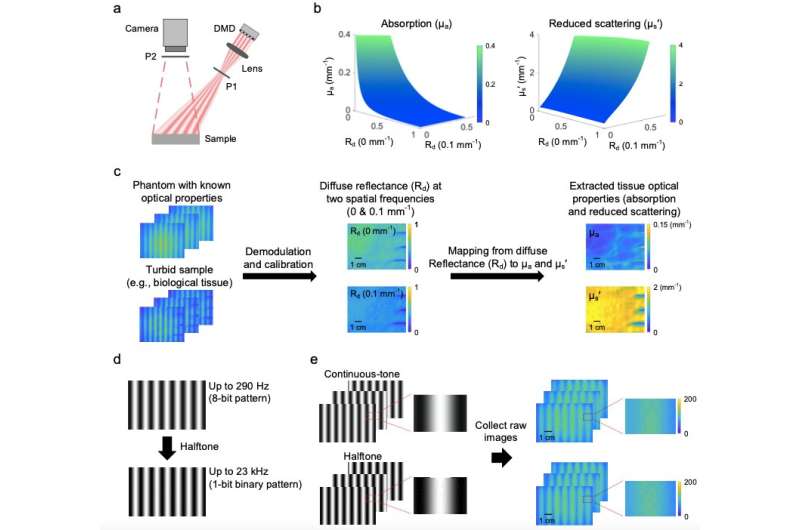Team develops kilohertz label-free non-contact quantitative mapping of optical properties for strongly turbid media

The ability to quantify optical properties (i.e., absorption and scattering) of strongly turbid media has major impacts on the characterization of biological tissues, fluid fields, and many others. However, the task of quantitative imaging of optical properties for strongly turbid media is intrinsically challenging, as photon scattering hinders direct measurement over length scales larger than the mean free path. Few current imaging technologies can quantify absorption and scattering properties of strongly turbid media in a wide-field non-contact format, and none have been shown to map quantitative optical properties with high-speed (e.g., kHz) capabilities.
In a new paper published in Light: Science & Application, Professor Yanyu Zhao, Professor Yubo Fan, and co-workers at Beihang University developed a new optical imaging method that for the first time can quantify optical properties of strongly turbid media as well as functional chromophore concentrations in tissue in a multi-kHz high-speed, label-free, non-contact, and wide-field manner. Their work was based on an emerging diffuse optical technology named spatial frequency domain imaging (SFDI). It can quantify optical properties of turbid media in a label-free, non-contact manner, and its camera-based detection scheme makes it intrinsically wide-field. It projects spatially modulated sinusoidal light patterns of different phases onto the sample using a digital-micromirror-device (DMD) and collects the reflectance images.
However, current SFDI technologies utilize a continuous-tone strategy and generate those sinusoidal patterns with 8-bit grayscale, which correspondingly has a limited maximum projection speed of 290 Hz determined by the DMD hardware. Consequently, while SFDI typically requires 5 projection patterns for the measurement of optical properties at a single wavelength, current SFDI technologies are severely limited for high-speed applications.
To address the bottleneck of measurement speed, the researchers proposed a halftone strategy to significantly increase the speed of SFDI by approximately two orders of magnitude, with no extra cost or modification on system hardware. Specifically, they first demonstrated the sinusoidal patterns generated by the halftone strategy for 1-bit DMD projection, which led to a maximum projection rate of 23 kHz, approximately two orders of magnitude faster than that in current SFDI technologies. They then validated the proposed halftone-SFDI against conventional SFDI measurements through experiments on an array of optical phantoms with a wide range of optical properties as well as in vivo human tissue. They also demonstrated dynamic monitoring of wide-field optical properties and functional chromophore concentrations in the rat brain cortex with the proposed halftone-SFDI. Enabled by the proposed method, they finally demonstrated kHz high-speed dual-wavelength monitoring of wide-field optical properties of a highly-dynamic flow field.
"To the best of our knowledge, this is the first demonstration of label-free non-contact imaging of quantitative optical properties of strongly turbid media with a speed of kilohertz," they noted.
"This work has several important implications for scientific research and engineering applications. For example, mapping brain cortex functions is of fundamental significance for brain science, neuroscience, and cognitive psychology. With shortwave-infrared wavelengths, the halftone-SFDI can provide kHz wide-field quantification of water content in the turbid combustion flow, which could have a substantial impact on the design and optimization of those engines and dramatically reduce related energy cost." they added.
"The presented technique can spatially map quantitative optical absorption and scattering properties with a maximum speed of 7.6 kHz in strongly turbid media, and can map absolute functional chromophore concentrations in tissue with a maximum speed of 3.8 kHz. This breakthrough could open a new venue for both fundamental research and translational applications including brain science and fluid dynamics." the scientists forecast.
More information: Yanyu Zhao et al, Halftone spatial frequency domain imaging enables kilohertz high-speed label-free non-contact quantitative mapping of optical properties for strongly turbid media, Light: Science & Applications (2021). DOI: 10.1038/s41377-021-00681-9
Journal information: Light: Science & Applications
Provided by Chinese Academy of Sciences





















